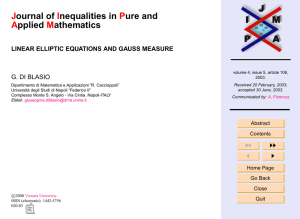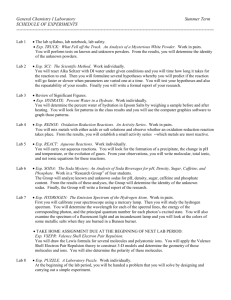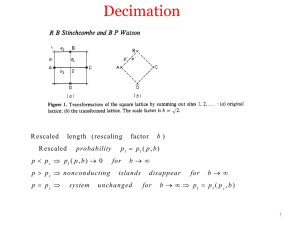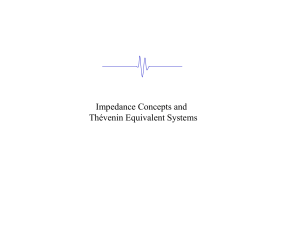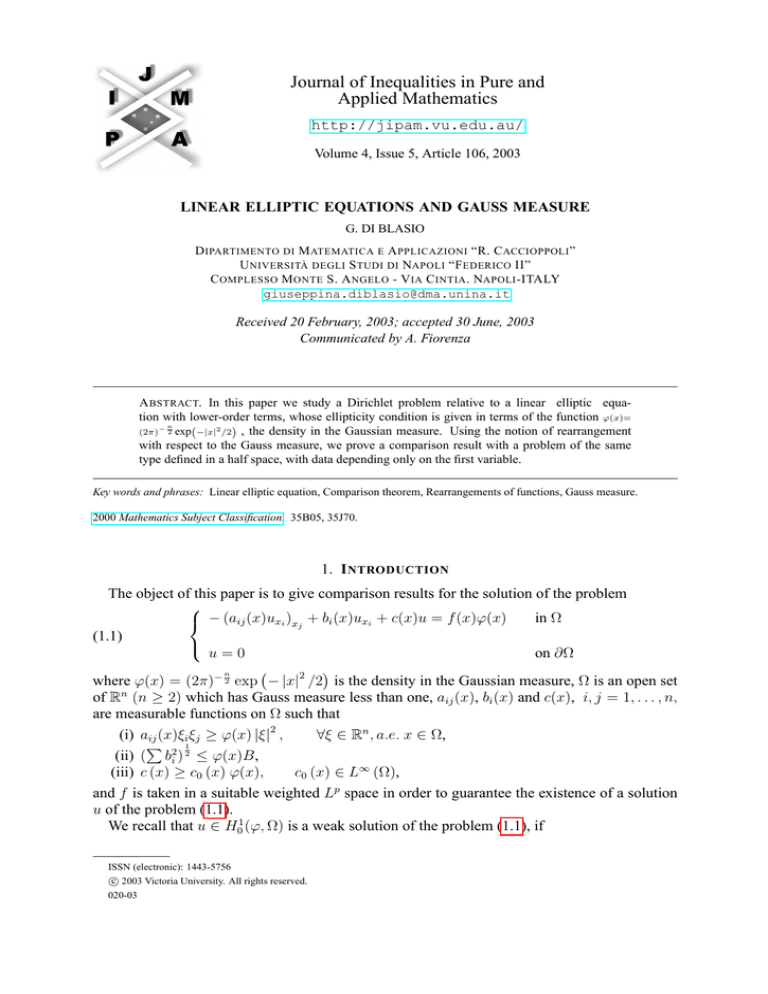
Journal of Inequalities in Pure and
Applied Mathematics
http://jipam.vu.edu.au/
Volume 4, Issue 5, Article 106, 2003
LINEAR ELLIPTIC EQUATIONS AND GAUSS MEASURE
G. DI BLASIO
D IPARTIMENTO DI M ATEMATICA E A PPLICAZIONI “R. C ACCIOPPOLI ”
U NIVERSITÀ DEGLI S TUDI DI NAPOLI “F EDERICO II”
C OMPLESSO M ONTE S. A NGELO - V IA C INTIA . NAPOLI -ITALY
giuseppina.diblasio@dma.unina.it
Received 20 February, 2003; accepted 30 June, 2003
Communicated by A. Fiorenza
A BSTRACT. In this paper we study a Dirichlet problem relative to a linear elliptic equation with lower-order terms, whose ellipticity condition is given in terms of the function ϕ(x)=
n
(2π)− 2 exp(−|x|2 /2) , the density in the Gaussian measure. Using the notion of rearrangement
with respect to the Gauss measure, we prove a comparison result with a problem of the same
type defined in a half space, with data depending only on the first variable.
Key words and phrases: Linear elliptic equation, Comparison theorem, Rearrangements of functions, Gauss measure.
2000 Mathematics Subject Classification. 35B05, 35J70.
1. I NTRODUCTION
The object of this paper is to give comparison results for the solution of the problem
in Ω
− (aij (x)uxi )xj + bi (x)uxi + c(x)u = f (x)ϕ(x)
(1.1)
u=0
on ∂Ω
n
where ϕ(x) = (2π)− 2 exp − |x|2 /2 is the density in the Gaussian measure, Ω is an open set
of Rn (n ≥ 2) which has Gauss measure less than one, aij (x), bi (x) and c(x), i, j = 1, . . . , n,
are measurable functions on Ω such that
(i) aij (x)ξi ξj ≥ ϕ(x) |ξ|2 ,
∀ξ ∈ Rn , a.e. x ∈ Ω,
P 2 12
(ii) ( bi ) ≤ ϕ(x)B,
(iii) c (x) ≥ c0 (x) ϕ(x),
c0 (x) ∈ L∞ (Ω),
and f is taken in a suitable weighted Lp space in order to guarantee the existence of a solution
u of the problem (1.1).
We recall that u ∈ H01 (ϕ, Ω) is a weak solution of the problem (1.1), if
ISSN (electronic): 1443-5756
c 2003 Victoria University. All rights reserved.
020-03
2
G. DI B LASIO
Z
Z
(aij (x)uxi ψxj + bi (x)uxi ψ + c(x)u(x)ψ)dx =
(1.2)
Ω
f (x)ϕ(x)ψdx, ∀ψ ∈ H01 (ϕ, Ω).
Ω
Let us observe that the operator in (1.1) is uniformly elliptic if Ω is bounded. It is well
known that when Ω is bounded, comparison results for elliptic problems have been obtained via
Schwarz symmetrization, for a simpler problem which is defined in a ball and has spherically
symmetric data (see for example [1], [2], [4], [3], [6], [17], [20], [19], [18], [21]).
In our case Ω can be not bounded and ellipticity condition (i) is given in terms of the density
in the Gaussian measure. We consider solutions of problem (1.1) in the weighted Sobolev space
H01 (ϕ, Ω) (see § 2) and we compare the solution of the problem (1.1) with the solution of a
problem in which the data depend only on the first variable and the domain is a half-space
which has the same Gauss measure as Ω.
More precisely let Ω? = {x = (x1 , x2 , . . . , xn ) ∈ Rn : x1 > λ} such that γn (Ω? ) = γn (Ω),
and let f ? (x) be the rearrangement with respect to the Gauss measure of the function f (x) (see
§ 2 for the definition). To give an example of the obtained results we consider the case c0 (x)
= 0.
Let w (x) = w (x1 ) be the solution of
in Ω? ,
− (wx1 ϕ (x))x1 − Bwx1 ϕ (x) = f ? (x1 )ϕ (x)
(1.3)
w=0
on ∂Ω? .
We prove that the pointwise comparison
(1.4)
u? (x) = u? (x1 ) ≤ w (x1 ) = w? (x)
for a.e x = (x1 , x2 , . . . , xn ) ∈ Ω?
holds, where u? and w? are the rearrangements with respect to the Gauss measure of u and
w respectively. In this case the comparison also gives an explicit estimate of u? that is also a
condition for the existence of the solution for the problem (1.1) in terms of the existence of the
solution of (1.3).
If c0 (x) 6= 0, a comparison with a problem which also takes the term “c(x) u(x)” into account
can be found. In this case, depending on the sign of c0 (x) , pointwise comparison (1.4) is false
in general, but a comparison between the concentrations can be found (see Theorem 3.4).
In the proofs of our results we use tools similar to the classical methods based on the isoperimetric inequality and Schwarz symmetrization (see [2]). In our case a fundamental rule is
played by the isoperimetric inequality with respect to the Gauss measure.
The problem (1.1) has been studied using rearrangement with respect to the Gauss measure
in [7], when bi (x) = c(x) = 0.
Existence results for weak solutions of problem (1.1) can be obtained for example via the
aij (x) c(x)
Lax Milgram theorem when (i) and (ii) hold and ϕ(x)
, ϕ(x) ∈ L∞ (Ω) and f (x) ∈ L2 (ϕ, Ω)
(see also [15], [22]).
2. N OTATIONS AND P RELIMINARY R ESULTS
In this section we recall some definitions and results which will be useful in what follows.
Let Ω be an open set of Rn and let γn be the n−dimensional Gauss measure on Rn defined by
!
2
n
|x|
γn (dx) = ϕ (x) dx = (2π)− 2 exp −
dx,
x ∈ Rn
2
normalized by γn (Rn ) = 1.
J. Inequal. Pure and Appl. Math., 4(5) Art. 106, 2003
http://jipam.vu.edu.au/
L INEAR E LLIPTIC E QUATIONS AND G AUSS M EASURE
3
One of the main tools used to prove the comparison result is the isoperimetric inequality with
respect to the Gauss measure, to recall this result we define the perimeter with respect to the
Gauss measure as (see [13])
!
Z
2
n
|x|
P (E) = (2π)− 2
exp −
Hn−1 (dx) ,
2
∂E
where E is a (n − 1)−rectificable set and Hn−1 denotes the (n − 1)−dimensional Hausdorff
measure. For all λ ∈ R, we denote by H (ξ, λ) the half-space defined by
H (ξ, λ) = {x ∈ Rn : (x, ξ) > λ}
and we set H (ξ, λ) = Rn if λ = −∞ and H (ξ, λ) = ∅ if λ = +∞.
It is well known (see [11]) that among all measurable sets of Rn with prescribed Gauss measure, the half-spaces take the smallest perimeter. In other words, the half-spaces are extremal
in the isoperimetric problem for the Gauss measure. From an appropriate form of the Brunn Minkowski inequality, the isoperimetric inequality follows (see [8], [11], [10], [12])
P (E) ≥ P (H (ξ, λ))
for all subsets E ⊂ Rn such that γn (E) = γn (H (ξ, λ)). For the sake of simplicity we shall
consider ξ = (1, 0, . . . , 0).
Now we consider the notion of rearrangement with respect to the Gauss measure. If u is a
measurable function in Ω, we define the distribution function of u, denoted by µ, as the Gauss
measure of the level set of u, i.e.
µ : t ∈ [0, ∞[ −→ µ (t) ∈ [0, 1] ,
where
µ (t) = γn ({x ∈ Ω : |u| > t}) .
We denote by u the decreasing rearrangement of u (with respect to the Gauss measure), i.e.
∗
u∗ (s) = inf {t ≥ 0 : µ (t) ≤ s} ,
s ∈ ]0, 1] ,
the functions µ and u∗ are decreasing and right - continuous. Moreover the increasing rearrangement of u is the function defined as follows
u∗ (s) = u∗ (γn (Ω) − s) ,
s ∈ [0, 1[ .
Finally we define the rearrangement of u with respect to the Gauss measure, denoted by u? ,
as the function whose level sets are half-spaces having the same Gauss measure of the level sets
of u. More precisely we define
2
Z +∞
1
t
n
Φ (τ ) = γn ({x ∈ R : x1 > τ }) = √
exp −
dτ
2
2π τ
for all τ ∈ R. Then u? is a map from Ω? into [0, +∞[ defined by
u? (x) = u∗ (Φ (x1 )) ,
where Ω? = {x = (x1 , x2 , . . . , xn ) ∈ Rn : x1 > λ} such that γn (Ω? ) = γn (Ω).
For statements about the properties of rearrangement with respect to a positive measure see,
for example, [9], [20], [16].
We recall that if f (x) , g (x) are measurable functions, a Hardy type inequality (see [9])
Z
Z
Z γn (Ω)
?
?
|f (x) g (x)| γn (dx) ≤
f (x) g (x) γn (dx) =
f ∗ (s) g ∗ (s) ds
Ω
Ω?
0
and a Polya-Szëgo inequality for a Lipschitz continuous function u (x) (see [20])
J. Inequal. Pure and Appl. Math., 4(5) Art. 106, 2003
http://jipam.vu.edu.au/
4
G. DI B LASIO
Z
Z
?
|∇u | γn (dx) ≤
(2.1)
|∇u| γn (dx)
Rn
Rn
holds. Moreover we have
Z
Z
p
|f (x)| γn (dx) =
Z
p
?
|f (x)| γn (dx) =
Ω?
Ω
γn (Ω)
f ∗ (s)p ds,
0
p
that is, the L weighted norm is invariant under the rearrangement.
Now define the weighted Sobolev space H01 (ϕ, Ω) as the closure of C0∞ (Ω) under the norm
Z
21
2
(2.2)
kukH 1 (ϕ,Ω) =
|∇u (x)| dγn (x) .
0
Ω
We remark that the following Poincarè type inequality can be proved.
Proposition 2.1. Let Ω be a open subset of Rn with γn (Ω) < 1. For each function f ∈
H01 (ϕ, Ω) we have
kf kL2 (ϕ,Ω) ≤ C k∇f kL2 (ϕ,Ω) ,
(2.3)
where C is a constant depending on n and Ω.
Proof. By (2.1) we have the following inequality
kf k2L2
(ϕ,Ω)
(2.4)
k∇f k2L2
(ϕ,Ω)
≤
kf ? k2L2
(ϕ,Ω? )
k∇f ? k2L2 ?
(ϕ,Ω )
2
x
2
?
f
(x
)
exp
− 21 dx1
1
λ
=R
,
2
2
+∞
x1
d
?
f (x1 ) exp − 2 dx1
dx1
λ
R +∞
where λ is such that γn (Ω? ) = γn (Ω) with Ω? = {x = (x1 , x2 , . . . , xn ) ∈ Rn : x1 > λ}. The
ratio in (2.4) is bounded (see e.g. [14, Theorem 1.3.1./2]).
The previous Poincaré type inequality ensures the equivalence between the norm (2.2) and
the following one
Z
12
12 Z
2
2
+
|∇u (x)| dγn (x) .
kukH 1 (ϕ,Ω) =
|u (x)| dγn (x)
0
Ω
Ω
Now, we recall the following lemmas which will be useful in the following.
Lemma 2.2. Let f (x) , g (x) be measurable, positive functions such that
Z α
Z α
f (x) dx ≤
g (x) dx,
α ∈ [0, a] .
0
0
If h(x) ≥ 0 is a decreasing function then
Z α
Z
f (x) h(x)dx ≤
0
α
g (x) h(x)dx,
α ∈ [0, a] .
0
Lemma 2.3. Let z be a bounded function, K a nonnegative integrable function, and ψ a function with bounded variation that vanishes at +∞. If
Z ∞
z (t) ≤
K (s) z (s) ds + ψ (t)
t
J. Inequal. Pure and Appl. Math., 4(5) Art. 106, 2003
http://jipam.vu.edu.au/
L INEAR E LLIPTIC E QUATIONS AND G AUSS M EASURE
5
for almost every t > 0, then
∞
Z
z (t) ≤
Z
exp
s
K (τ ) dτ [−dψ (s)]
t
t
for almost every t > 0.
3. C OMPARISON R ESULTS
In this section we prove some comparison results for the solution of the problem (1.1). We
consider first the case c0 (x) = 0 and then the case c0 (x) 6= 0.
Theorem 3.1. Let Ω be an open set of Rn with γn (Ω) < 1 and let u ∈ H01 (ϕ, Ω) be the solution
of (1.1) with the assumptions (i), (ii) and (iii). Let c0 (x) = 0 and
Z
+∞
exp
(3.1)
λ
τ2
2
Z
+∞
σ2
f (σ) exp B (σ − τ ) −
2
?
τ
2
dσ
dτ < +∞,
where λ is such that Ω? = {x1 > λ} . Then we have
u? (x1 ) ≤ w(x)
(3.2)
for a.e. x ∈ Ω?
and
Z
Z
q
|∇w|q ϕ (x) dx
|∇u| ϕ (x) dx ≤
(3.3)
for all 0 < q ≤ 2,
Ω?
Ω
where
Z
w (x) = w (x1 ) =
x1
exp
λ
τ2
2
Z
τ
+∞
σ2
f (σ) exp B (σ − τ ) −
2
?
dσ dτ
is the solution of the problem (1.3).
Remark 3.2. Condition (3.1) ensures the existence of a solution w (x1 ) = w? (x) ∈ H01 (ϕ, Ω)
of (1.3). It is satisfied for a wide class of functions, for instance for functions f such that
1
σ2
?
f ≤ exp −B (σ − τ ) +
(1 + |τ |) 2 −
∀τ ≥ λ
4
for some constants C > 0, > 0.
Remark 3.3. The assumption γn (Ω) < 1 is made to guarantee that the Poincarè type inequality
(2.3) holds.
Proof. If we choose in (1.2), for h > 0 and t ∈ [0, sup |u|[
h sgn u
if |u| > t + h,
(|u| − t) sgn u if t < |u| ≤ t + h,
ψ(x) =
0
otherwise,
J. Inequal. Pure and Appl. Math., 4(5) Art. 106, 2003
http://jipam.vu.edu.au/
6
G. DI B LASIO
we get
Z
1
aij (x)uxi uxj dx
h t<|u|≤t+h
Z
Z
1
+
bi (x)uxi (|u| − t) sgn udx +
bi (x)uxi sgn udx
h t<|u|≤t+h
|u|>t+h
Z
Z
1
+
c(x) (|u| − t) sgn udx +
c(x)u (x) sgn udx
h t<|u|≤t+h
|u|>t+h
Z
Z
1
=
f (x)ϕ(x) (|u| − t) sgn udx +
f (x)ϕ(x) sgn udx.
h t<|u|≤t+h
|u|>t+h
By the ellipticity condition (i), (ii) and (iii) and letting h go to 0, we obtain
Z
Z
Z
d
2
(3.4)
−
|∇u| ϕ(x)dx ≤ B
|∇u| ϕ (x) dx +
f (x) sgn uϕ(x)dx
dt |u|>t
|u|>t
|u|>t
On the other hand, the coarea formula (see [13]) and the isoperimetric inequality with respect
to the Gauss measure give
Z
Z
d
(3.5)
−
|∇u| ϕ(x)dx ≥
ϕ(x)Hn−1 (dx)
dt |u|>t
∂{|u|>t}?
!
Φ−1 (µ (t))2
1
,
= √ exp −
2
2π
where {|u| > t}? is the half space having Gauss measure µ(t).
Then using (3.5) and the Hölder inequality we obtain
!
12
Z
2
−1
1
1
d
Φ
(µ
(t))
2
0
2
(3.6)
1 ≤ (2π) 2 exp
(−µ (t)) −
|∇u| ϕ(x) dx .
2
dt |u|>t
Using (3.6) and the Hölder inequality, (3.4) becomes
Z
d
−
|∇u|2 ϕ(x)dx
dt |u|>t
Z ∞
Z
1
d
2
2
≤ B (2π)
−
|∇u| ϕ(x)dx exp
ds |u|>s
t
Φ−1 (µ (s))2
2
Z
0
× (−µ (s)) ds +
!
µ(t)
f ∗ (s) ds.
0
By Gronwall’s Lemma 2.3 we obtain
Z
d
(3.7)
−
|∇u|2 ϕ(x)dx
dt |u|>t
"
Z
µ(t)
≤
exp B (2π)
0
Z
=
1
2
Z
µ(t)
exp
r
Φ−1 (τ )2
2
!
#
dτ f ∗ (r) dr
µ(t)
exp B(Φ−1 (r) − Φ−1 (µ (t))) f ∗ (r) dr.
0
J. Inequal. Pure and Appl. Math., 4(5) Art. 106, 2003
http://jipam.vu.edu.au/
L INEAR E LLIPTIC E QUATIONS AND G AUSS M EASURE
7
Using again (3.6) we have
(3.8)
1 ≤ 2π exp Φ−1 (µ (t))2 (−µ0 (t))
Z
µ(t)
exp B(Φ−1 (r) − Φ−1 (µ (t))) f ∗ (r) dr.
0
Then using (3.8) and integrating between 0 and t, (3.7) becomes
Z γn (Ω)
Z σ
−1
2
t ≤ 2π
exp Φ (σ)
exp B(Φ−1 (s) − Φ−1 (σ)) f ∗ (s) dsdσ,
µ(t)
0
which, putting µ (t) = s and s = Φ (x1 ) , gives
(3.9)
u? (x) = u? (x1 )
2 Z +∞
Z x1
τ
σ2
?
≤
exp
f (σ) exp B (σ − τ ) −
dσ dτ,
2
2
λ
τ
where λ is such that γn (Ω? ) = γn (Ω) with Ω? = {x = (x1 , x2 , . . . , xn ) ∈ Rn : x1 > λ} . This
completes the proof of (3.2) observing that the right-hand side of (3.9) is the solution of (1.3).
Let us prove now (3.3). Using the Hölder inequality and (3.7) we have
Z
d
(3.10) −
|∇u|q ϕ (x) dx
dt |u|>t
! 2q
Z µ(t)
q
1−
≤ (−µ0 (t)) 2
exp B(Φ−1 (r) − Φ−1 (µ (t))) f ∗ (r) dr
.
0
By (3.6) we have
(3.11)
0
− 2q
(−µ (t))
− 2q
(2π)
2q
i d Z
h q 2
2
−1
exp −
Φ (µ (t)) ≤ −
|∇u| ϕ (x) dx .
2
dt |u|>t
Using (3.11), (3.7) and integrating between 0 and +∞, (3.10) becomes
q
Z γn (Ω) Z s
Z
∗
q
q
−1
−1
|∇u| ϕ (x) dx ≤ (2π) 2
exp B(Φ (r) − Φ (s)) f (r) dr
Ω
0
0
h q i
2
−1
× exp
Φ (s) ds
2
q
Z +∞ Z +∞
2
1
σ
?
= (2π) 2
f (σ) exp B (σ − τ ) −
dσ
2
λ
τ
q 2 τ2
× exp τ −
dτ,
2
2
that is, (3.3).
In the next theorem we consider the case c0 (x) 6= 0 and we compare problem (1.1) with a
“symmetrized” problem which also takes account of the influence of the term “c (x) u (x)”.
Theorem 3.4. Let Ω be an open set of Rn with γn (Ω) < 1 and let u ∈ H01 (ϕ, Ω) be a solution
of (1.1) with the assumptions (i), (ii) and (iii). Moreover, let
−
+
+
c+
0 (x) = max {c0 (x), 0} , c0 (x) = max {−c0 (x), 0} , c0? (x) = c0∗ (Φ(x1 )).
J. Inequal. Pure and Appl. Math., 4(5) Art. 106, 2003
http://jipam.vu.edu.au/
8
G. DI B LASIO
We will assume that the problem
− (wx1 ϕ (x))x1 − Bwx1 ϕ (x)
−?
?
?
+ c+
(3.12)
0? (x1 ) − c0 (x1 ) wϕ(x) = f (x1 )ϕ (x) in Ω ,
w=0
on ∂Ω? ,
has a solution w(x) = w? (x1 ). Then
u∗ (s) ≤ w∗ (s)
holds in [0, s01 ] , where s01 = inf s : c+
0∗ (s) > 0 , and
Z s
Z s
∗
u (r) dr ≤
w∗ (r) dr
0
holds in
]s01 , γn
0
(Ω)].
Proof. Using (iii), the Schwartz inequality and the Hardy inequality we have,
Z
Z
(3.13)
−
c(x) |u| dx ≤ −
c0 (x) |u| ϕ(x)dx
|u|>t
|u|>t
Z
≤−
µ(t)
∗
+
c0∗ (s) − c−∗
0 (s) u (s)ds,
0
c+
0∗ (s)
where
is the increasing rearrangement of c+
0 (x) and µ(t) is the distribution function of
u(x). Proceeding as in Theorem 3.1 and using (3.13) we obtain
Z
d
|∇u|2 ϕ(x)dx
(3.14) −
dt |u|>t
12
Z
Z ∞
1
d
2
≤B
−
|∇u| ϕ(x)dx (−µ0 (s)) 2 ds
ds |u|>s
t
Z µ(t)
Z µ(t)
+
∗
−∗
−
c0∗ (s) − c0 (s) u (s)ds +
f ∗ (s)ds.
0
0
By (3.6) we have
(3.15)
Z
−1 2 1
d
2
≤ 2π exp Φ (s)
−
|∇u| ϕ(x)dx .
−µ0 (t)
dt |u|>t
Following the same steps as in Theorem 3.1 and using (3.14), (3.15) becomes
Z
−1 2 s
∗ 0
(3.16) (−u ) (s) ≤ 2π exp Φ (s)
exp B(Φ−1 (r) − Φ−1 (s))
0
∗
+
× [f ∗ (r) + [c−∗
0 (r) − c0∗ (r)]u (r)]dr.
Now if we consider the problem (3.12) we can proceed in the same way except that the
inequalities should be replaced by equalities.
Then if we call w(x) = w? (x) the solution of the problem (3.12), we obtain the following
equality
Z
−1 2 s
∗ 0
(3.17) (−w ) (s) = 2π exp Φ (s)
exp B(Φ−1 (r) − Φ−1 (s))
0
+
∗
× [f ∗ (r) + [c−∗
0 (r) − c0∗ (r)]w (r)]dr.
J. Inequal. Pure and Appl. Math., 4(5) Art. 106, 2003
http://jipam.vu.edu.au/
L INEAR E LLIPTIC E QUATIONS AND G AUSS M EASURE
9
To prove the comparison result, we put v(s) = u∗ (s) − w∗ (s). By (3.16) and (3.17) we have
Z
−1 2 s
0
(3.18) (−v) (s) ≤ 2π exp Φ (s)
exp B(Φ−1 (r) − Φ−1 (s))
0
+
× [c−∗
0 (r) − c0∗ (r)]v (r) dr.
+
0
6 0 and let us put s01 = inf s : c+
Let
suppose c−∗
0∗ (s) > 0 and s0 =
0 (x) , c0∗ (x) =
us −∗
sup s : c0 (s) > 0 . We write
Z s
V1 (s) =
exp B(Φ−1 (r) − Φ−1 (s)) c−∗
s ∈ [0, s00 ]
0 (r) v(r)dr,
Z0 s
V2 (s) =
exp B(Φ−1 (r) − Φ−1 (s)) c+
s ∈ ]s01 , γn (Ω)] .
0∗ (r) v(r)dr,
s01
0
We assume initially that c−∗
0 (s) is continuous at s0 , we have to prove, now, that V1 (s) ≤ 0.
Arguing as in [1] we observe that the existence of a solution w (x) = w? (x) of (3.12), that
implies (3.17), guarantees that the problem:
0
−1 0
− c−∗
Z (s) = (2π) exp Φ−1 (s)2 Z (s) + 2π exp Φ−1 (s)2
0 (s)
Rs
× 0 exp [B(Φ−1 (r) − Φ−1 (s))] f ∗ (r) dr,
Z (0) = Z 0 (s00 ) = 0,
has the following positive solution
Z s
∗
exp B(Φ−1 (r) − Φ−1 (s)) c−∗
Z (s) =
0 (r) w (r)dr.
0
This allows us to state (see [5]) that the problem
0
−1 0
c−∗
ξ (s) + λ (2π) exp Φ−1 (s)2 ξ (s) = 0,
0 (s)
(3.19)
ξ (0) = ξ 0 (s00 ) = 0,
has the first eigenvalue λ1 > 1, and consequently in the following problem
0
−1 0
c−∗
V1 (s) + 2π exp Φ−1 (s)2 V1 (s) ≥ 0,
0 (s)
V1 (0) = V10 (s00 ) = 0,
we have
V1 (s) ≤ 0
and
V10 (s) ≤ 0,
s ∈ [0, s00 ] ,
that is,
u∗ (s) ≤ w∗ (s),
(3.20)
s ∈ [0, s00 ] .
On the other hand, from (3.18) and (3.20), we have
0
−1 0
c+
V2 (s) − 2π exp Φ−1 (s)2 V2 (s) ≥ 0,
0∗ (s)
V2 (s01 ) = V20 (γn (Ω)) = 0.
J. Inequal. Pure and Appl. Math., 4(5) Art. 106, 2003
http://jipam.vu.edu.au/
10
G. DI B LASIO
Here we can use the maximum principle to obtain V2 (s) ≤ 0. For Lemma 2.2 with h(r) =
−1
0
c+
0∗ (r) , we have for each s ∈ ]s1 , γn (Ω)] ,
Z s
(3.21)
exp B(Φ−1 (r) − Φ−1 (s)) u∗ (r)dr
s01
Z
s
≤
exp B(Φ−1 (r) − Φ−1 (s)) w∗ (r)dr,
s01
that is,
u∗ (s01 ) ≤ w∗ (s01 ).
On the other hand, from (3.16), (3.17), (3.20) and the definition of v (s) we have
−v 0 (s) ≤ 0,
s ∈ [s00 , s01 ] .
Now since u∗ (s01 ) ≤ w∗ (s01 ), integrating between s and s01 we obtain
u∗ (s) ≤ w∗ (s),
(3.22)
s ∈ [s00 , s01 ] .
From (3.20) and (3.22) we have
u∗ (s) ≤ w∗ (s),
s ∈ [0, s01 ] .
Moreover, for s ∈ s01, γn (Ω) , (3.21) becomes
Z s
0≥
exp B(Φ−1 (r) − Φ−1 (s)) [u∗ (r) − w∗ (r)]dr,
0
that is,
Z
s
∗
Z
u (r)dr ≤
0
s
w∗ (r)dr,
s ∈ [s01 , γn (Ω)] .
0
0
Finally we can remove the hypothesis about the continuity of c−∗
0 (s) at s0 proceeding by approximations.
−∗
0
0
If c+
0∗ (x) = 0 or c0 (x) = 0 then s1 = γn (Ω) or s0 = 0 and the result follows with the
obvious modifications.
R EFERENCES
[1] A. ALVINO, P.L. LIONS AND G. TROMBETTI, Comparison results for elliptic and parabolic
equations via Schwarz symmetrization, Ann. Inst. H. Poincaré Anal. Non Linéaire, 7 (1990), 37–
65.
[2] A. ALVINO AND G. TROMBETTI, Sulle migliori costanti di maggiorazione per una classe di
equazioni ellittiche degeneri, Ricerche Mat., 27 (1978), 413–428.
[3] A. ALVINO AND G. TROMBETTI, Equazioni ellittiche con termini di ordine inferiore e riordinamenti, Atti Accad. Naz. Lincei Cl. Sci. Fis. Mat. Nater. Rend. Lincei (8), 66 (1979), 194–200.
[4] A. ALVINO AND G. TROMBETTI, Su una classe di equazioni ellittiche non lineari degeneri,
Ricerche Mat., 29 (1980), 193–212.
[5] C. BANDLE, Isoperimetric Inequalities and applications, Pitman London, 1980.
[6] M.F. BETTA, F. BROCK, A. MERCALDO AND M.R. POSTERARO, A weighted isoperimetric
inquality and application to symmetrization, J. Inequal. Appl., 4 (1999), 215–240.
[7] M.F. BETTA, F. BROCK, A. MERCALDO AND M.R. POSTERARO, A comparison related to
Gauss measure, C.R. Acad. Sci. Paris, 334, Serie I, (2002), 451–456.
[8] C. BORELL, The Brunn-Minkowski inequality in the Gauss space, Invent. Math., 30 (1979), 194–
200.
J. Inequal. Pure and Appl. Math., 4(5) Art. 106, 2003
http://jipam.vu.edu.au/
L INEAR E LLIPTIC E QUATIONS AND G AUSS M EASURE
11
[9] K.M. CHONG AND N.M. RICE, Equimisurable rearrangements of Sobolev functions, J. Reine
Angew. Math., 384 (1988), 153–179.
[10] A. EHRHARD, Symmétrisation dans l’space de Gauss, Math. scand., 53 (1983), 281–301.
[11] A. EHRHARD, Inégalités isoperimétriques et intégrales de Dirichlet Gaussiennes, Ann. Scient. Éc.
Norm. Sup., 4e sèrie, 17 (1984), 317–332.
[12] A. EHRHARD, Éléments extremaux pour les inégalitès de Brunn-Minkowski gaussennes, Ann.
Inst. H. Poincarè Anal. non linèaire, C(1986), 149–168.
[13] H. FEDERER, Geometric measure theory, Grundlehren der Mathematischen Wissenschaften, 153,
Springer-Verlag, 1969.
[14] G. MAZ’JA , Sobolev Spaces, Springer-Varlag, Berlin Heidelberg New York Tokyo (1980).
[15] M.K.W. MURTY AND G. STAMPACCHIA, Boundary value problems for some degenerate elliptic
operators, Ann. Mat. Pura Appl., 80 (1968), 1–122.
[16] J. M. RAKOTOSON AND B. SIMON, Relative rearrangement on a measure space. Application to
the regularuty of weighted monotone rearrangement. Part1, Part2, Rev. R. Acad. Ciend. Exact. Fis.
Nat. (Esp), 91 (1997), 17–31.
[17] G. TALENTI, Elliptic Equations and Rearrangements, Ann. Scuola Norm. Sup. Pisa Cl. Sci., 3
(1976), 697–718.
[18] G. TALENTI, Nonlinear elliptic equation, rearrangements of functions and Orlicz spaces, Ann.
Mat. Pura Appl., 120 (1979), 156–184.
[19] G. TALENTI, Linear Elliptic P.D.E.’s:Level Set, Rearrangements and a priori Estimates of Solutions, Boll. Un. Mat. Ital. B, 6 4-B (1985), 917–949.
[20] G. TALENTI, A weighted version of a rearrangement inequality, Ann. Univ. Ferrara, Sez. VII
(NS), 43 (1997), 121–133.
[21] G. TROMBETTI, Metodi di simmetrizzazione nelle equazioni a derivate parziali, Boll. Un. Mat.
Ital. B, 3 (2000), 601–634.
[22] N.S. TRUDINGER, Linear elliptic operators with measurable coefficients, Ann. Scuola Norm. Sup.
Pisa, 27 (1973), 265–308.
J. Inequal. Pure and Appl. Math., 4(5) Art. 106, 2003
http://jipam.vu.edu.au/



